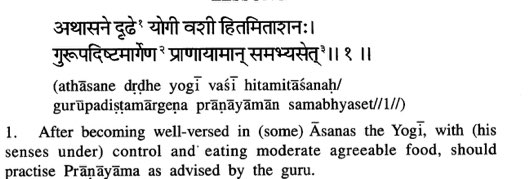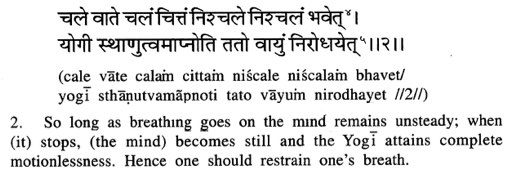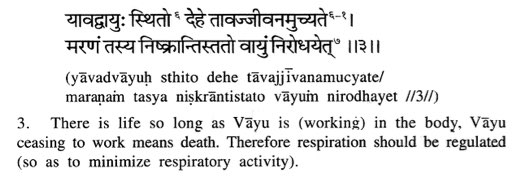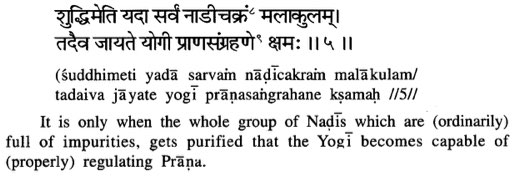Working of Five Main Vayus and Prana in Modern Medical language in relation to Pranayama
An attempt to understand
‘Working of Five Main Vāyus & Prāna’
in Modern Medical language in relation to Prānāyāma
National Seminar on Holistic Health through Yoga
Organized by Lakulish Yoga University Surendranagar, Gujarat.
5th - 7th Jan. 2018
Dr. Mukund V. Bhole, M.D., D.Sc.(Yoga)
ABSTRACT
It has been proposed that, ‘operationally, ‘vāyus’ should be interpreted as ‘motor activity’ and ‘prāna’ as ‘sensory activity’ giving rise to ‘knowledge’ & ‘understanding’.
‘Prānāyāma’, will then mean ‘increasing one’s knowledge base’ related with particular type of ‘vāyu’ or motor activity.
For research studies, it is proposed that working with ‘Mechanics of Breathing’ would be more appropriate than working with ‘Gaseous exchange’ in relation to ‘Prānāyāma’ related with in-breath (svāsa) and out-breath (prasvāsa) & body movements related with breathing (prāna-apāna vāyus).
INTRODUCTION
Understanding the Concepts of Vāyus, Prāna and Prānāyāma
Traditional Hatha Yoga Texts such as ‘Goraksha Shataka’, ‘Siddha Siddhānta Paddhati’, ‘Hathapradipikā’, ‘Shiva Samhitā’ ‘Gheranda Samhitā’, ‘Kumbhaka Paddhati’ refer to the concepts of ‘Ten vāyus’, ‘Five prānās’ and ‘Two Breaths’ (svāsa-prasvāsa) while elaborating the topic of ‘Prānāyāma’.
It is observed that the words “vāyu, vāta, prāna, pavana, samīrana, anila, māruta, marut, svasana, prabhanjana” are used indiscriminately as synonyms in many yoga texts without explaining the logic and reasoning for doing so.
This becomes quite confusing & misleading for people wanting to plan and execute educational, therapy & research programs related with these concepts and doctrines and present their results before hard core scientists and critical minded people. Modern writers on these subjects in various languages are also seen to follow the same trend of Indian writers without making any effort to highlight their logic and reasoning for doing so.
Other writers prefer to avoid mentioning these terms and use totally new terms. Apart from this, there is great tendency to present ‘Prāna Vāyu’ as Oxygen (O2) and ‘Apāna Vāyu’ as Carbon dioxide’ (CO2).
Carbon dioxide gas was discovered around 1640 & Oxygen gas was discovered around 1773-74. (Ref.: Google wikipedia). The term “Vāyu” appears in Vedic and Yoga literature dating back to 300 to 500 BCE. It is presumed that Gorakshanath, author of SSP & GS lived around 11th century AD.
Therefore, it is wrong to equate O2 with ‘Prāna Vāyu’ and CO2 with ‘Apāna Vāyu’.
Research studies on Prānāyāma (Kumbhakās) conducted in laboratories are usually based on ‘Gaseous exchange’ using sophisticated instruments, while one is supposed to be working with different ‘Vāyus’ (Main: prāna, apāna, vyāna, samāna & udāna and Secondary: nāga, kūrma, krukal, devadutta & dhananjaya) without the help of external instruments.
An attempt has been made to give an operational definition and understanding of some of these terms selected from Hathapradipikā in modern medical language for undertaking educational and research activities.
References from Critical Edition of ‘Hathapradipikā’ in relation to ”Vāyus, Prāna” and “Prānāyāma”:





DISCUSSION
Samkhya Karika (SK)-33 mentions manas, buddhi & ahamkāra constituting ‘antah-karana’. SK-23, 24 & 27 refer to the sensory and motor functions of the ‘manas’, determination quality of the ‘buddhi’ and ‘ahamkāra’ being capable of action. PYS-II:54 refers to ‘Pratyāhāra’ which qualifies the sādhaka to practice ‘Antaranga Yoga’.
Almost all of us will realize and agree that we cannot sense Oxygen (O2) and/or Carbon-di-oxide (CO2) with our five senses and ‘manas’.
Therefore, we cannot make any decisions about their presence and concentrations inside or outside the body using our ‘buddhi’ nor we can voluntarily modify their consumption, exchange or elimination using ‘ahamkara’.
It is very easy and convenient for scientists to study O2-CO2 concentrations, volumes, tensions, elimination, absorption, exchange etc. using suitable instruments in laboratory. (Objective study). But, it is not possible to get any knowledge about these gases inside our body without using external instruments. (Subjective experience)
Therefore, it is totally wrong to equate ‘prāna and apāna vāyus’ of yoga with O2-CO2 of modern medical science, even though they are very important in our life. We have to make efforts to find appropriate understanding of different Vāyus mentioned in Yoga literature.
Therefore, it has been proposed that “different physical and/or psycho-physical movements” could be understood as “ten vāyus” and getting knowledge of these movements as “prāna” for practical instructions, therapy and research purposes.
Knowledge of these movements along with other kind of knowledge acquired through the five senses should be recognized as “prāna”. Extension of this knowledge (prāna) will mean ‘prnāyāama’.
Working with five main “Vayus” with special reference to “Prana and Apana Vayus” in an experiential way will be dealt with in the practical session.
CONCLUSION
1.There is a dire need to re-interpret commonly followed and used interpretations of the terms ‘Vāyus’ and ‘Prāna’ more clearly and specific way so that it could easily understood by those educated in modern medical sciences in order to have clear understanding of the approach in traditional Yoga education systems.
2.Motor activities or actions could be understood as “Vāyus” and getting their knowledge as “Prāna”.
3.Increasing our knowledge base of these movements will mean “Prānāyāma”. It could be then related with one’s breathing activity and the movement of breath as taught in Yoga class.
Just like food and water, even though gaseous exchange related with O2-CO2 gases is of vital importance to our survival, we cannot sense, monitor and modify them during Yoga practices. On the other hand, it is easy to get the knowledge and understanding of various happenings related with the movements of the body and the breath and to work with that knowledge for our health and Yoga Sādhanā.
REFERENCES
Important Reference Books used for this study.
1.Hathapradīpikā of Svātmārām: Critical edition published by Kaivalyadhama Samiti, Lonavala, 1998. Chapt.II, Verses 1 to 5.
1.Goraksha-shatakam: Published by K-dhama Samiti, Lonavala. Verses 24-25.
2.Siddha-Siddhanta Paddhati of Gorakshanath: Critical edition published by Lonavala Yoga Institute, Lonavala, 2016. Chapt.I, Verse 67 (atha dasha-vayavah).
3.Shiva Samhita: Critical edition published by K-dhama Samiti, Lonavala, 1999. 3rd Patala, Verses 4 to 8 (atha dasha-vayavah).
4.Hathapradipika Jyotsna: Critical edition published by Kaivalyadhama Samiti, Lonavala, 2002. Chapt.II, Verses 1-5.
5.Therapeutic References in Traditional Yoga Texts: Critical edition published by Lonavala Yoga Institute, Lonavala, 2010. Chapt. III (Pranayama).
6.Kumbhaka Paddhati of Raghuvira: Critical edition published by Lonavala Yoga Institute, Lonavala, 2005. Verses 9 to 11, 47, 56, 62, 65, 76
7.Yoga Kosha: Pblished from Kaivalyadhama Samiti, Lonavala, 1991. pp. 223 to 227; 291-292.
PRACTICAL CLASS
Working with the concepts of Five Main Vāyus, Prāna and Prānāyāma in Yoga Sadhana.
Since early childhood we are performing following types of gross body movements:
1. Movements in one direction at a time.
2. Balancing movements.
3. Movement in vertical direction.
Let us have a quick revision of these types of gross body movements.
-
-
1.Forward-Backward & Lateral movements.
-
2.Standing on one leg with open and closed eyes.
-
3.Moving in vertical direction.
-
-
Sit or lie down in suitably comfortable position:
- Start recognizing tensions and other disturbing messages arising from the body.
- Make a mental note of the areas of disturbing messages and the nature of these disturbances.
- Try to reduce their intensity or eliminate them completely in order to feel more and more relaxed and comfortable.
-
-Make sure that you are not making voluntary body movements mentioned earlier.
-
-Are you able to recognize any involuntary gross body movements which could be easily sensed, monitored and modified by you voluntarily?
- Can you describe the nature of these movements, if recognized by you?
- Interactions with the participants about their observations regarding body movements other than the three ones.
- What is the nature of the movements?
- Can you describe them in yogic, medical or your own language?
- Helping the participants to experience and recognize expanding and retracting movements of the body taking place all the time.
- They are usually recognized being related with breathing. However, they are related with many vital functions responsible for our survival and existence.
Introducing the concepts of:
-
-
1.Ten Vāyus,
-
2.Five Prānās,
-
3.Two Breaths.
-
-
Their Sanskrit names along with possible medical understanding.
1) TEN VAYUS:
A) Five main ‘vāyus’
-
-
Prāna vāyu
-
Apāna vāyu
-
Vyāna vāyu
-
Samāna vāyu
-
Udāna vāyu
-
-
B) Five Secondary or Subsidiary vayus:
-
Nāga Vāyu
-
Kūrma Vāyu
-
Krukala Vāyu
-
Devdutta Vāyu
-
Dhananjaya Vāyu
-
2) FIVE PRANAS:
-
-
Prāna
-
Apāna
-
Vyāna
-
Samāna
-
Udāna
-
-
3) TWO BREATHS: (1) Svāsa and (2) Prasvāsa
More practices, such as four positions in lying down positions and the influence of these position on the experiential aspects of expanding-retracting body movements, related with breathing. (prāna vāyu and apāna vāyu).
Reciting relevant verses from important Yoga Texts related to the practice:
Sthira-sukham asanam (PYS- II:46)
Prayatna-shaithilya-anant-samapattibhyam (II:47)
Tasmin-sati-svasa-prasvasayor-gati-vicchedah pranayama (PYS – II:49)
Bahya-abhyantara-stambha-vruttir-desh-kala-samkhyabhih
paridrusto dirgha-sukshmah (II:50)
Dr. M.V.Bhole
04/02/18

Dr M.V. Bhole - © Copyright 2011

